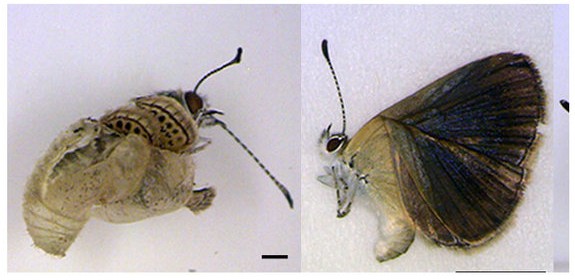Mutant Butterflies In Fukushima

The mutant butterflies have been shown to have stunted wings, irregularly developed eyes, disfigured antennas and different color patterns. Butterflies from irradiated regions have led scientists to say they have found evidence to suggest a link between the genetic mutations and the radioactive material that was leaked into the environment.
“We conclude that artificial radionuclides from the Fukushima Nuclear Power Plant caused physiological and genetic damage to this species,” said the researchers’ report, which was published in the journal Scientific Reports.
The study was one of the first to explore the genetic impacts of the disaster.
Two months after the Fukushima nuclear accident, researchers collected 144 adult pale grass blue butterflies from 10 locations in Japan, including the Fukushima area.
Lead researcher Joji Otaki from the University of the Ryukyus in Okinawa said the results were surprising.
“It has been believed that insects are very resistant to radiation,” Otaki said. “In that sense, our results were unexpected.”
According to the study, the team found that areas with higher levels of radiation in the environment were home to butterflies with more mutant characteristics. In all, about 12 percent of the 144 butterflies were found to be mutant butterflies.
Though this news is perhaps disturbing enough, what researchers say is even more alarming is that these mutations are spreading rapidly through subsequent generations.
When Otaki and his team bred the butterflies in a laboratory setting, they discovered that a whole “suite of abnormalities that hadn’t been seen in the previous generation” began to appear.
Moreover, six months after the first collection, researchers found that butterflies from the Fukushima area showed a mutation rate “more than double” that of those found two months after the accident.
The researchers concluded that this higher rate of mutation likely came from butterfly larvae eating contaminated leaves and also from mutations of genetic material being passed on to subsequent generations by mutant parents.
Otaki stated, “Since we’ve seen these effects on butterflies, it’s easy to imagine that it would also have affected other species as well.” “It’s pretty clear that something has gone wrong with the ecosystem.”
The Fukushima nuclear disaster occurred after a 9.0-magnitude earthquake knocked out a power line at the plant. The earthquake triggered a tsunami that flooded the facility’s emergency generators, causing meltdowns to occur in three reactors. Within days, thousands of residents were evacuated from the area as radioactive material continued to leak into the environment.

 Print
Print